Each task assessment item assesses one aspect of driving performance during the execution of an assessable task at a specific location on the test route. For example, observation might be assessed when turning right from Smith Street into Jones Road.
Task assessment items are not assessed while driving between assessable tasks. They contribute to the applicant’s point score for stage 1 or for the entire test.
There are 10 task assessment items that may be assigned to an assessable task, as follows:
- observation
- signalling
- gap selection
- speed choice
- following distance
- lateral position
- parking observation
- parking movement
- leaving park
- turning movement.
Observation
Explanation
Safe, effective driving is achieved when drivers observe and assess the ever-changing driving environment in front of, to both sides and to the rear of their vehicles. Throughout the test the applicant must demonstrate thorough observation skills. This includes using mirrors and performing head checks (as appropriate).
Requirements
- Maintains a continuous lookout ahead of the vehicle, except when making brief checks of the mirrors and other directions.
- When driving straight, checks the mirrors often enough to maintain awareness of surrounding traffic. The required frequency varies with traffic conditions.
- When required to give way to other traffic (such as when facing a Give Way sign, turning across oncoming traffic, approaching a pedestrian crossing or entering a roundabout), looks in the direction(s) from which conflicting traffic (or pedestrians) might approach before proceeding.
- Checks the relevant mirror(s) immediately before braking.
- Prior to turning or diverging (including when entering or crossing a special vehicle lane in preparation for a left turn):
- checks the relevant mirror(s) immediately before signalling
- performs a head check immediately before moving laterally (if appropriate).
- When turning, looks in the planned direction of travel (ie in the direction of the turn) before making the turn.
- When making a three-point turn, looks in both directions along the road and does head check immediately before moving across the road (before and after reversing) and immediately before reversing away from the kerb.
- When reversing as part of a three-point turn, looks in the direction of travel while reversing.
- Prior to driving over a railway crossing, looks in both directions for approaching
rail vehicles.
Signalling
Explanation
Communication with other road users is an important aspect of safely sharing the road. A vehicle’s indicators provide the main means of communicating a driver’s intention to change direction. The applicant needs to demonstrate their ability to apply the appropriate signals throughout the test, irrespective of traffic conditions.
Requirements
- Activates the turn indicator for the appropriate direction (left or right) for at least three seconds (even if no other traffic is present) before:
- turning
- pulling out from the kerb
- pulling into the kerb
- changing lanes
- diverging left or right by at least the width of the car (other than pulling out from the kerb)
- diverging by less than the width of the car in circumstances where it is necessary to warn other road users of the intended movement (eg to indicate that the applicant intends to overtake a parked car before allowing an oncoming vehicle to pass)
- stopping next to a parked vehicle to commence a reverse parallel park.
- When turning at a roundabout:
- activates the turn indicator in the appropriate direction (left or right) for at least three seconds prior to entering the roundabout
- activates the left turn indicator before leaving the roundabout.
- When travelling straight ahead at a roundabout:
- does not signal prior to entering the roundabout
- activates the left turn indicator before leaving the roundabout.
- When turning left or right, does not activate the turn indicator so early that it might mislead other road users about which street the applicant intends to turn into.
- Maintains the turn signal until the turn or diverge has been completed.
- Cancels the turn indicator if necessary when the turn or diverge has been completed.
| Traffic movement |
Task |
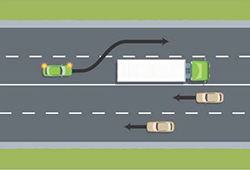 |
Figure 23 Signals when changing lanes. |
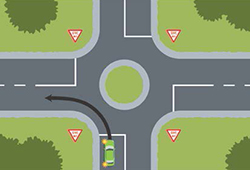 |
Figure 24 If turning left, signals left on approach and leaves on until roundabout has been exited. |
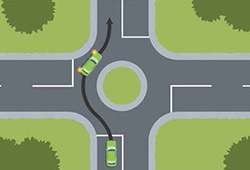 |
Figure 25 If moving straight ahead signals left to exit (if practicable to do so) when passing the entry point immediately before the required exit. |
 |
Figure 26 If turning right, signals right on approach and in the roundabout, then signals left to exit (if practicable to do so) when passing the entry point immediately before the required exit. |
Gap selection
Explanation
Correct gap selection should allow any manoeuvre to be completed safely without causing other road users to adjust their speed or direction.
Drivers who reject safe gaps increase congestion and delays, leading to frustration for other road users. The applicant must demonstrate safe and appropriate gap selection consistently throughout the test.
Requirements
- Selects the first available safe gap in traffic after an initial period of observing approaching traffic to identify a gap.
- Rejects any unsafe gaps.
Speed choice
Explanation
The applicant must observe the speed limit at all times. The applicant also needs to adjust the vehicle’s speed to suit the prevailing driving conditions (road, weather, light, driver, vehicle or traffic conditions).
Requirements
- Does not exceed the speed limit by 5km/h or more at any time.
- When driving straight, drives at or close to the speed limit when conditions are suitable, but at a lower speed if road, weather or traffic conditions (eg driving on a wet or unsealed road, or in congested or slow traffic) make it unsafe to travel at the speed limit.
- When merging, adjusts speed if necessary to choose a safe gap in the traffic.
Following distance
Explanation
The applicant needs to maintain a safe following distance between the car being driven and the vehicle in front by applying the appropriate 2-second or 4-second rules throughout the test.
Requirements
- When driving straight in good conditions, maintains a following distance of at least 2 seconds behind the vehicle ahead.
- When driving straight in poor conditions (eg on a wet or unsealed road), maintains a following distance of at least 4 seconds behind the vehicle ahead.
- After changing lanes, resumes the applicable following distance (2 or 4 seconds, depending on conditions) behind the vehicle in front as soon as practicable.
Lateral position
Explanation
The applicant must position the vehicle in a safe and legal position throughout the test.
Requirements
- On roads with more than one lane marked for the applicant’s direction of travel, selects an appropriate lane for the driving task.
- When turning left or right from a road with marked lanes, commences the turn from a lane from which the relevant turn (left or right) is permitted.
- When turning into a multi-lane road, turns into the nearest lane, and does not mislead other drivers by turning towards one lane and then changing direction to finish in a different lane.
- When travelling on a road with a flush median, uses the flush median to:
- wait before turning right (see Figure 27)
- wait to move into a gap in the traffic flow after you have turned right (see Figure 28).
- When travelling straight through an intersection, does not select a lane marked for turning traffic only.
- Does not drive in a special vehicle only lane (eg bus or bicycle), except when:
- entering or leaving the road
- pulling over to or out from the kerb
- passing a right-turning vehicle
in which cases the applicant is permitted to drive in a special vehicle lane for up to 50 metres.
Note: This exception does not apply in the case of a cycle lane where the applicant has a separate marked lane for their intended direction of travel which is clearly differentiated from the cycle lane.
- Where there is more than one lane available, selects the appropriate lane to travel in (eg does not travel in the left lane if it is intermittently blocked by parked vehicles and another lane is available).
- When turning right:
- keeps left of the centre line (if any) or centre of the road (if no centre line) when entering the intersection and when leaving the intersection (see Figure 29, Figure 30 and Figure 31)
- if turning from a road without marked lanes, enters the intersection as near as practicable to the centre line (if any) or the centre of the road
- if turning right at an intersection other than a T-intersection or a roundabout, passes to the right of the centre of the intersection, unless road markings impose a different requirement.
- When turning left:
- does not cross the centre line of either the road the applicant is turning from or the road the applicant is turning into
- if turning left from a road without marked lanes, commences the turn from as near as practicable to the left side of the road.
- Positions the vehicle wholly within the lane (except when changing lanes) and does not wander from side to side within the lane.
- When driving along a road with only one lane or line of traffic for the applicant’s direction of travel, positions the vehicle as near as practicable to the left side of the road. Note that it is not considered practicable to drive close to the left side of the road if this would require the applicant to diverge frequently around parked vehicles.
- Maintains a lateral clearance of at least 1.2 metres from parked vehicles, whenever possible.
- Maintains a lateral distance of at least 1.5 metres from cyclists, whenever possible.
- Maintains a safe lateral clearance from vehicles travelling in other lanes.
| Traffic movement |
Task |
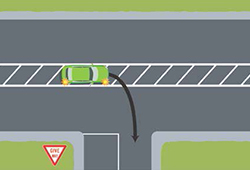 |
Figure 27 Using a flush median to wait before turning right. |
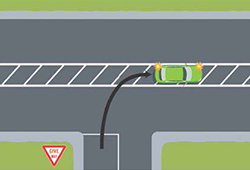 |
Figure 28 Using a flush median to wait to move into a gap in the traffic flow after you have turned right. |
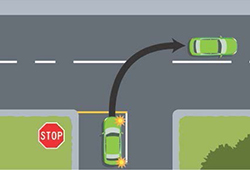 |
Figure 29 Correct lateral position on a right turn, keeping left of centre when entering and leaving the intersection. |
 |
Figure 30 Correct lateral position for a right turn into a multi-lane road.
|
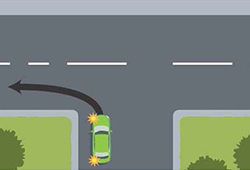 |
Figure 31 Correct lateral position for a left turn from a road with no marked lanes, entering the intersection as near as practicable to the left side of the road. |
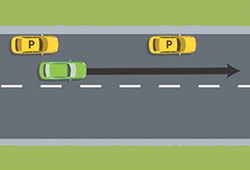 |
Figure 32 Correct lateral position when cars are parked at the left side of the road (note: ‘P’ indicates a parked vehicle). |
Parking observation
Explanation
Reversing is a necessary driving skill which will be tested during the test. The preferred option is a reverse parallel park but applicants may be asked to conduct a three-point turn in areas where no suitable spaces are available to conduct a reverse parallel park.
Requirements
- Checks the relevant mirror(s) and does head check immediately before reversing.
- When reverse parking, maintains observation to the rear.
Parking movement
Explanation
The applicant must be able to satisfactorily manoeuvre the vehicle when completing a reverse parallel park.
Requirements
- Completes the reverse parallel park in no more than four vehicle movements (as shown in Figure 34) and in no more than two minutes (unless traffic conditions make this unreasonable).
- Does not reverse more than 7 metres behind the rear of the vehicle in front (measured from the rear of the parked vehicle to the front of the applicant’s car).
- Finishes with the vehicle parallel to and within 300mm of the kerb.
- Finishes 1–2 metres from the vehicle in front.
- Does not hit the kerb heavily enough to cause discomfort to vehicle occupants.
- Does not allow any wheel to mount the kerb while parking.
| Traffic movement |
Task |
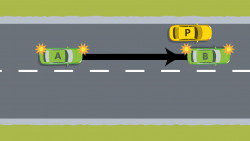 |
Figure 33 Indicating when stopping next to a parked vehicle for a reverse parallel park movement. The applicant is required to maintain a turn signal at positions A and B. |
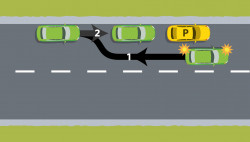 |
Figure 34 Reverse parallel park manoeuvre (no more than 4 movements). Movements 3 and 4 (not shown) can be used to
correct the vehicle’s position. |
Leaving park
Explanation
Marking of the reverse parallel park manoeuvre will include the applicant exiting the park and rejoining the traffic flow.
Requirements
- Checks in the relevant mirror(s), if safe signals and makes a head check immediately before pulling out from the kerb.
- Pulls out from the kerb in either one or two movements (ie one reverse movement if required, and one forward movement).
| Traffic movement |
Task |
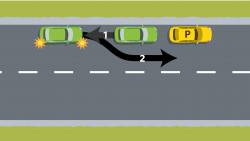 |
Figure 35 Leaving parking, using one
reverse movement and one forward
movement (note: ‘P’ indicates a parked vehicle). |
Turning movement
Explanation
On those occasions where the testing officer may be unable to find a suitable location for the reverse parallel park the applicant will be requested to conduct a three-point turn.
Requirements
When performing a three-point turn, the applicant must not make use of driveways on either side of the road nor may they complete the manoeuvre as a U-turn.
- Positions the car parallel to and within 300mm of the left kerb.
- Moves across the road to the right kerb without hitting any kerb hard enough to cause discomfort to vehicle occupants and without allowing any wheel to mount a kerb.
- Does not use a driveway and does not allow the vehicle to enter private property.
- Reverses away from the kerb without hitting any kerb hard enough to cause discomfort to vehicle occupants and without allowing any wheel to mount a kerb.
- Returns to the correct side of the road when driving off as the manoeuvre is completed.
- Completes the manoeuvre in no more than two minutes and without moving across the road to the right more than once.
| Traffic movement |
Task |
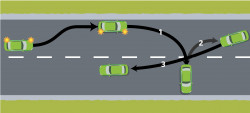 |
Figure 36 Three-point turn movements, including pulling over to the left kerb. The applicant is required to signal before pulling over to the kerb and before moving across to the right. |













